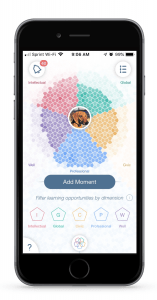Information technology plays a pivotal role in the Northeastern 2025 vision of limitless learning and discovery, opening new possibilities and creating new networks. With that said, all too often, technology can be seen as a barrier for reaching our true potential. This happens for all sorts of reasons, but a key one to consider is that while we invest in technology solutions, we rarely match that investment in making sure our people are able to utilize those solutions with a high degree of digital dexterity. We don’t invest enough in training our teams and we centrally struggle with helping the community envision novel ways to use our existing technology to solve their challenges. We aspire to challenge this status quo through an overarching vision of crafting a framework for the Digital University. I believe we are beginning to see it come together through new organizational designs and rethinking some of our roles and responsibilities.
What do I mean by a Digital University? Step back and think about how technology threads its way through nearly every facet of our environment. Our networks enable communication, collaboration, the movement of research data, the discovery of knowledge, and so much more. Our data stores hold answers to nearly all of the questions we struggle to answer. Our enterprise systems power administrative and educational operations so that people get paid, classes are scheduled, assignments are turned in, alumni can engage, students can apply, and so much more. To truly build a modern university, we have to lead our community to think digital-first across all of our functions. We must continue to push to be an institution that leverages technology to enhance student success, business outcomes, the discovery of knowledge, and employee experience. It’s removing physical, geographic, and cultural boundaries and encouraging communication and collaboration anywhere, anytime, and with anyone. We are a global university that has to find ways to effortlessly connect across the network.

Digital dexterity refers to our ability as an institution to participate in a digital environment with ease and overall enjoyment. Not only will introducing new tools help us work smarter, it can lead to an enhanced experience will doing our jobs. As a singular example, I see a convergence of tools in the Microsoft Office 365 (O365) suite and all that it has to offer as a key component in this thinking. But as I mentioned earlier, it isn’t just about the tools it is also about how we work to guide our faculty, staff, and students in the appropriate and effective use of these tools. To that end we have recently created a new position to focus on how collaboration tools (both in and out of O365) can be effectively leveraged to make us all better at what we do.
Our focus on digital transformation pushes us to accept that we have to constantly evaluate and critically consider our existing technological investments — particularly the ones that are our enterprise foundation. We have kicked off a multi-year program to replace our identity and access management environment to make sure we are thinking about digital identity in ways that allows us all to take advantage of the growing number of digital tools. We are investigating and building new, personalized mobile first views of data from these systems with the goal of putting all the tools faculty, staff, and students need in their hands. And when we think about that, we want to provide the ability to not only find information quickly, but to also be able to act once discovered. In other words, we want to bring what you need to you regardless of the system it resides in. If you want to pay a semester bill, check your room assignment, or hear about your schedule you shouldn’t have to figure out where that information is. We want to give you a single and personalized opportunity to get to it with simplicity and we will be doing that in a new mobile platform that is being designed.
 Finally, the concept of the digital academy is to bring together our experiential teaching and learning philosophies in ways that technology can positively impact. SAIL is a clear example of how we can enhance a student’s holistic experience as a member of the Northeastern community. That is only a single example and one component of that ecosystem. We must see our digital teaching and learning environment as a core competency that is to be invested in and consistently enhanced. ITS has a huge role to play along with partners across campus in supporting faculty and students’ appropriate use of digital tools to enhance teaching, learning, and research.
Finally, the concept of the digital academy is to bring together our experiential teaching and learning philosophies in ways that technology can positively impact. SAIL is a clear example of how we can enhance a student’s holistic experience as a member of the Northeastern community. That is only a single example and one component of that ecosystem. We must see our digital teaching and learning environment as a core competency that is to be invested in and consistently enhanced. ITS has a huge role to play along with partners across campus in supporting faculty and students’ appropriate use of digital tools to enhance teaching, learning, and research.
I’m thrilled by the progress I have seen since my arrival less than a year ago. At the same time, there is much more work to be done to build our Digital University. But I believe we’re up for the challenge, and we’ll stay the course to get there together. I invite you to share this ride with me, and I hope you come along. With that said, think of this as an invitation to help us craft our institution’s digital future. It impacts all of us.
[/et_pb_text][/et_pb_column][/et_pb_row][/et_pb_section]
